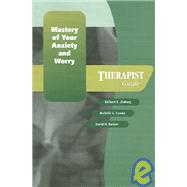
| Chapter 1: Structure of the Mastery of Your Anxiety and Worry Program and Practical Issues in Its Implementation | 1 | (14) | |||
|
2 | (1) | |||
|
3 | (1) | |||
|
4 | (1) | |||
|
5 | (1) | |||
|
6 | (1) | |||
|
7 | (1) | |||
|
7 | (3) | |||
|
10 | (1) | |||
|
11 | (1) | |||
|
11 | (2) | |||
|
13 | (1) | |||
|
14 | (1) | |||
| Chapter 2: The Nature of Anxiety and Generalized Anxiety Disorder | 15 | (8) | |||
|
15 | (3) | |||
|
18 | (2) | |||
|
20 | (3) | |||
| Chapter 3: Outline of Treatment Procedures and Basic Principles Underlying Treatment | 23 | (8) | |||
|
24 | (1) | |||
|
24 | (1) | |||
|
25 | (2) | |||
|
27 | (3) | |||
|
30 | (1) | |||
| Chapter 4: Lesson 1 The Nature of Generalized Anxiety | 31 | (12) | |||
|
31 | (1) | |||
|
32 | (1) | |||
|
33 | (1) | |||
|
33 | (7) | |||
|
40 | (3) | |||
| Chapter 5: Lesson 2 Learning to Recognize Your Own Anxiety | 43 | (6) | |||
|
43 | (1) | |||
|
43 | (1) | |||
|
44 | (1) | |||
|
44 | (3) | |||
|
47 | (2) | |||
| Chapter 6: Lesson 3 The Purpose and Function of Anxiety | 49 | (8) | |||
|
49 | (1) | |||
|
50 | (1) | |||
|
51 | (1) | |||
|
52 | (3) | |||
|
55 | (2) | |||
| Chapter 7: Lesson 4 A Closer Look at Generalized Anxiety Disorder | 57 | (8) | |||
|
57 | (1) | |||
|
58 | (1) | |||
|
59 | (1) | |||
|
59 | (4) | |||
|
63 | (2) | |||
| Chapter 8: Lesson 5 Learning to Relax | 65 | (6) | |||
|
65 | (1) | |||
|
66 | (1) | |||
|
67 | (1) | |||
|
68 | (1) | |||
|
69 | (2) | |||
| Chapter 9: Lesson 6 Controlling Thoughts That Cause Anxiety I: Overestimating the Risk | 71 | (8) | |||
|
71 | (1) | |||
|
72 | (1) | |||
|
73 | (1) | |||
|
74 | (2) | |||
|
76 | (3) | |||
| Chapter 10: Lesson 7 Controlling Thoughts That Cause Anxiety II: Thinking the Worst | 79 | (8) | |||
|
79 | (1) | |||
|
80 | (1) | |||
|
80 | (1) | |||
|
81 | (4) | |||
|
85 | (2) | |||
| Chapter 11: Lesson 8 Direct Worry Control | 87 | (6) | |||
|
87 | (1) | |||
|
88 | (1) | |||
|
89 | (1) | |||
|
89 | (3) | |||
|
92 | (1) | |||
| Chapter 12: Lesson 9 From Worry Exposure to Worry Prevention | 93 | (8) | |||
|
93 | (1) | |||
|
94 | (1) | |||
|
94 | (1) | |||
|
95 | (3) | |||
|
98 | (3) | |||
| Chapter 13: Lesson 10 Dealing With Real Problems | 101 | (6) | |||
|
101 | (1) | |||
|
102 | (1) | |||
|
102 | (1) | |||
|
103 | (3) | |||
|
106 | (1) | |||
| Chapter 14: Lesson 11 Drugs for Anxiety and Their Relation to This Program | 107 | (6) | |||
|
107 | (1) | |||
|
107 | (1) | |||
|
108 | (1) | |||
|
108 | (3) | |||
|
111 | (2) | |||
| Chapter 15: Lesson 12 Your Accomplishments and Your Future | 113 | (6) | |||
|
113 | (1) | |||
|
113 | (1) | |||
|
114 | (1) | |||
|
115 | (2) | |||
|
117 | (2) | |||
| References | 119 | (2) | |||
| Additional Readings | 121 |
The New copy of this book will include any supplemental materials advertised. Please check the title of the book to determine if it should include any access cards, study guides, lab manuals, CDs, etc.
The Used, Rental and eBook copies of this book are not guaranteed to include any supplemental materials. Typically, only the book itself is included. This is true even if the title states it includes any access cards, study guides, lab manuals, CDs, etc.